Table of Contents
-
In September 2024, Google took a rare manual action against Forbes Advisor, wiping out nearly 20 million monthly visits.
-
Forbes Advisor’s digital PR team drove over 70,000 referring domains before the penalty.
-
As of May 2025, the site had regained nearly 4 million in traffic (~17%) of its original 24 million monthly visits.
- Traffic recovery correlated strongly with category-level links (0.77), versus just 0.14 at the individual page level.
-
Recovery seemed tied to creating Helpful content more than simply cutting ties with freelance writers.
In September 2024, Google took manual action against Forbes Advisor for site reputation abuse, rocking the SEO world.
This drop led to rampant theories and posts about their actions, why, and how.
Unfortunately, around 25 great digital PRs on the Forbes Advisor team who were doing great work were also let go (as were many editors and SEOs).
Fast forward to May 2025, and it looks as though they are beginning to recover.
So, in this post, I want to take a deeper look at what dropped, what came back, and lastly, what digital PR may have to do with its resurgence.
Methodology: Using Ahrefs’ Site Explorer, I compared the Top Pages and Best By Links reports. I also excluded regional subfolders like /it/ in this analysis.
Quick Background
The former Director of PR & Communications, Mark LoCastro, told me that since 2022, the Forbes Advisor section of the site has generated over 70K Referring Domains (RD).
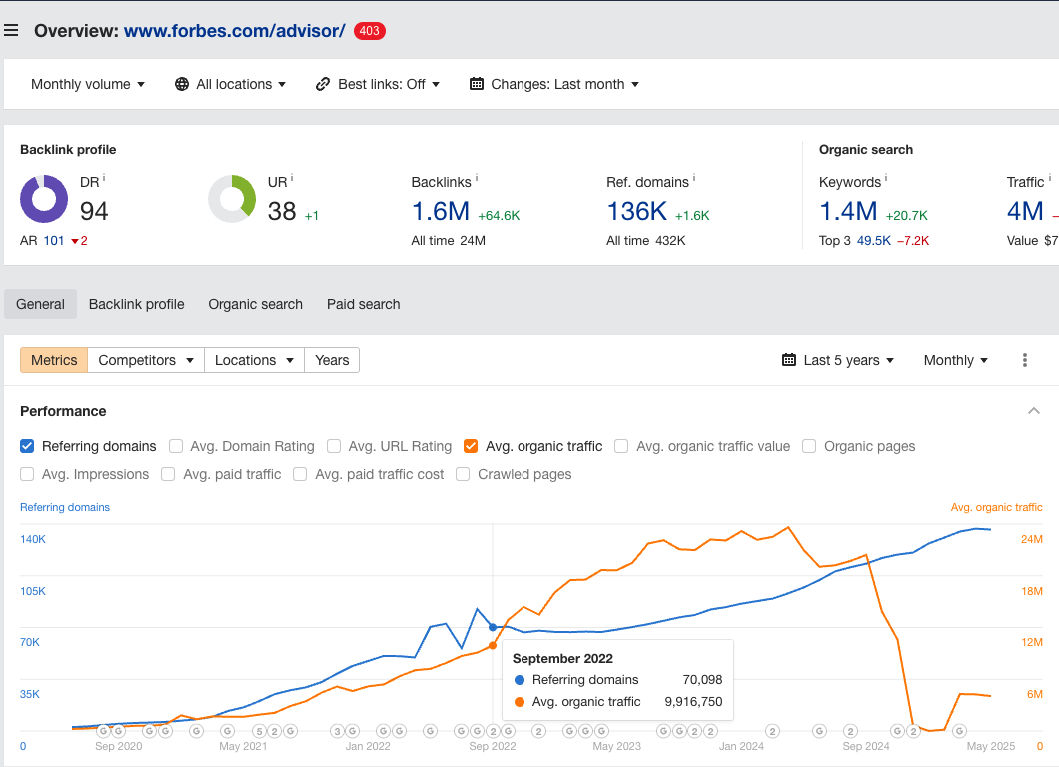
At their peak, his team of 29 digital PRs was churning out a few hundred articles yearly.
Then, in March 2024, Google’s March 2024 core update hit the Forbes Advisor section and lost about 8 million in traffic.
Many sites were hit during this time, but this was only the beginning.
They recovered some of their traffic, but in mid-September 2024, Forbes Advisor was seemingly hit with a manual action by Google for site reputation abuse. (Google never confirmed this 100%.)
Google has defined (and redefined) its site reputation abuse policy as the “practice of publishing third-party pages on a site in an attempt to abuse search rankings by taking advantage of the host site’s ranking signals.”
According to Ahrefs Site Explorer, by February 2025, their traffic dipped to near zero:
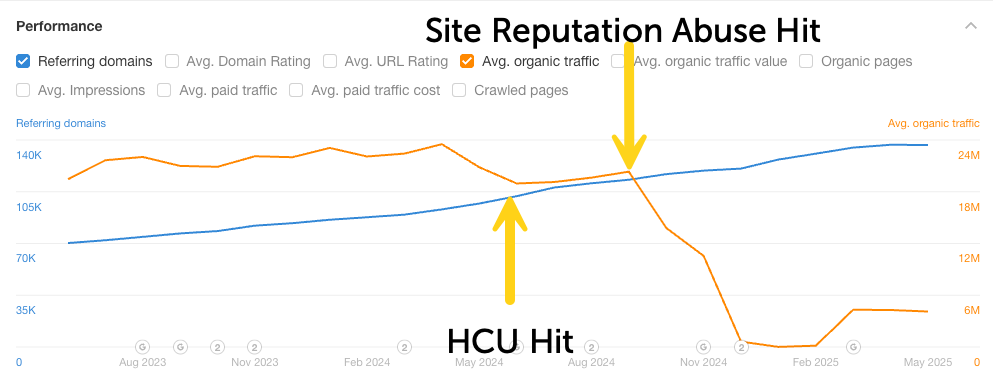
Then, out of nowhere, in March 2025, the site traffic started to come back.
Why?
That’s what I’m looking to find out.
To understand their recovery, let’s first turn back time to understand what used to rank.
Part One: What Used to Rank?
Here’s a look at their top content.
Forbes Advisor was crushing with currency converters and investing content at their peak in April 2024.
| URL | Traffic |
|---|---|
| https://www.forbes.com/advisor/money-transfer/currency-converter/usd-ngn/ | 292,277 |
| https://www.forbes.com/advisor/investing/gold-price/ | 195,056 |
| https://www.forbes.com/advisor/mortgages/mortgage-rates-04-22-24/ | 186,628 |
| https://www.forbes.com/advisor/investing/silver-price/ | 170,247 |
| https://www.forbes.com/advisor/money-transfer/currency-converter/aed-inr/ | 159,716 |
| https://www.forbes.com/advisor/banking/savings/best-high-yield-savings-accounts/ | 143,480 |
| https://www.forbes.com/advisor/money-transfer/currency-converter/sar-pkr/ | 137,391 |
| https://www.forbes.com/advisor/money-transfer/currency-converter/eur-inr/ | 129,356 |
| https://www.forbes.com/advisor/car-insurance/best-car-insurance-companies/ | 125,853 |
| https://www.forbes.com/advisor/money-transfer/currency-converter/aed-pkr/ | 124,972 |
Like the one below, their currency converter pages brought in over an estimated 6.6 million organic visits:
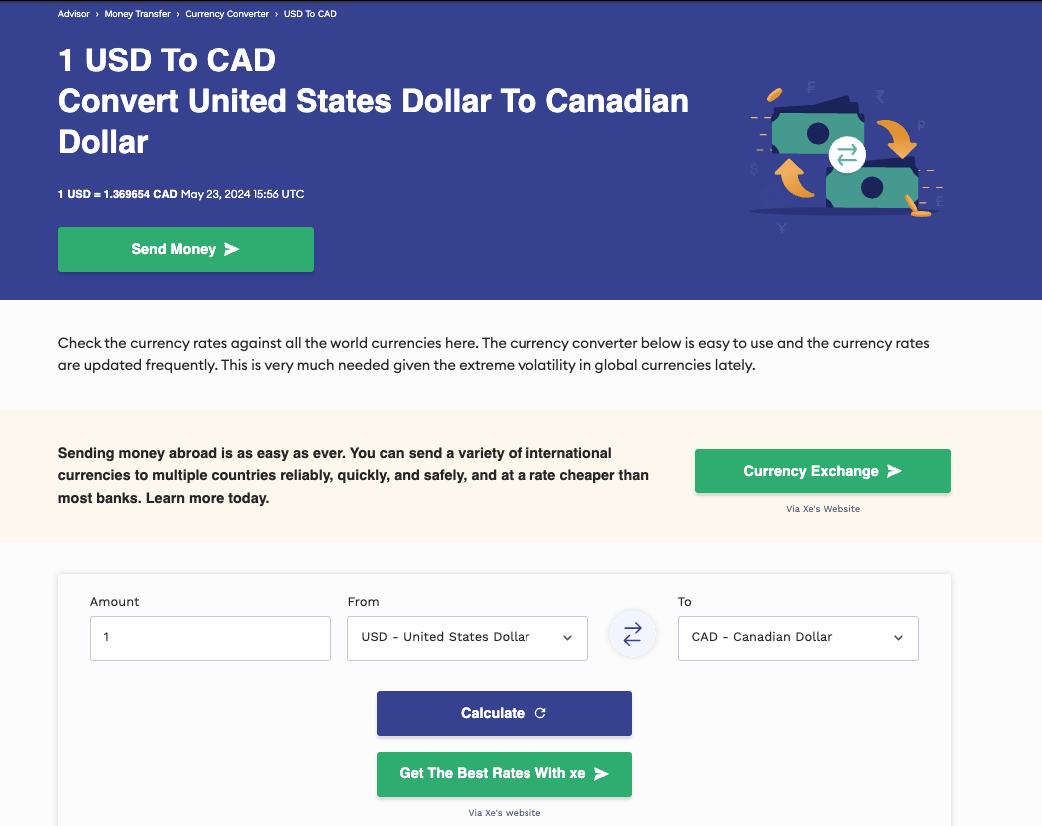
Here’s a macro look from the category/sub-folder level:
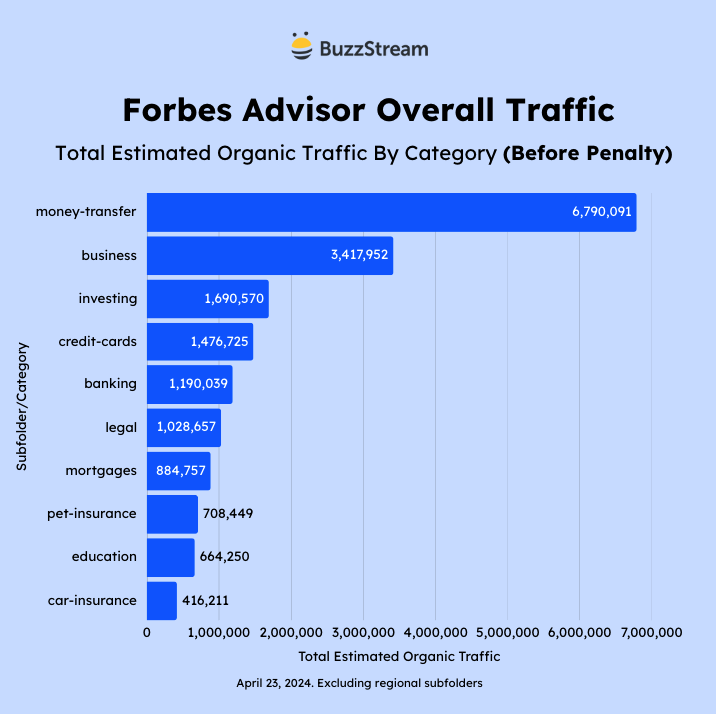
As you can see, the /money-transfer/ section led the way, followed by /business/ and /investing/.
The business and investing content was a mix of informative content on topics like bitcoin halving or what accounting is, as well as affiliate-based review content, like best web hosting services.
Next, let’s look at how digital PR fueled their growth.
How Did Digital PR Fuel Their Growth?
We’ve analyzed digital PR’s impact on SEO growth in the past. I believe Forbes Advisor’s traffic follows those same patterns, as evidenced by the healthy link growth in tandem with the organic traffic growth:
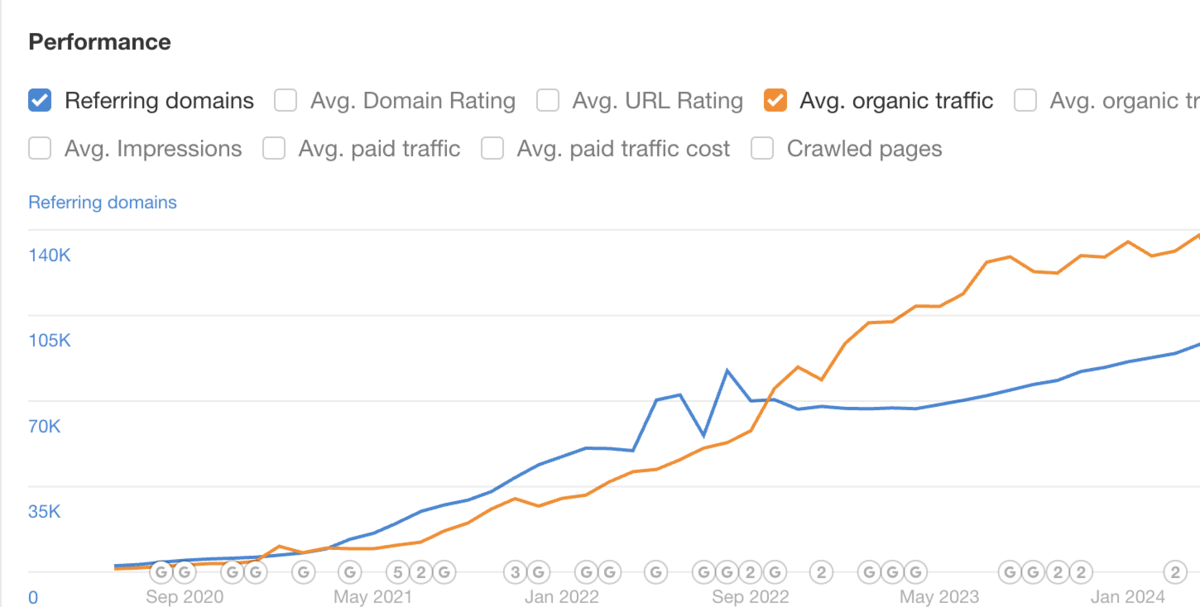
So, I want to understand what Forbes Advisor and their excellent digital PR team had in terms of impact.
I spoke with one source who worked on the digital PR team who gave me a quick summary:
“In terms of Forbes Advisor’s Digital PR strategy, the approach back then was definitely pretty aggressive and heavily aligned with supporting the site’s key monetized categories.
…we invested a lot into proprietary surveys, data-led studies, and the stats pages, those were a massive part of the playbook.
We were always looking for data hooks that could generate media coverage while naturally reinforcing topical authority on high-intent verticals like insurance, loans, credit cards, etc.”
Let’s take a quick look at some of these strategies:
1. Passive Link Magnet Posts
If you look at the anchors for the past year’s backlinks, you can see that data studies seem to drive most of the backlinks to the Forbes Advisor content.
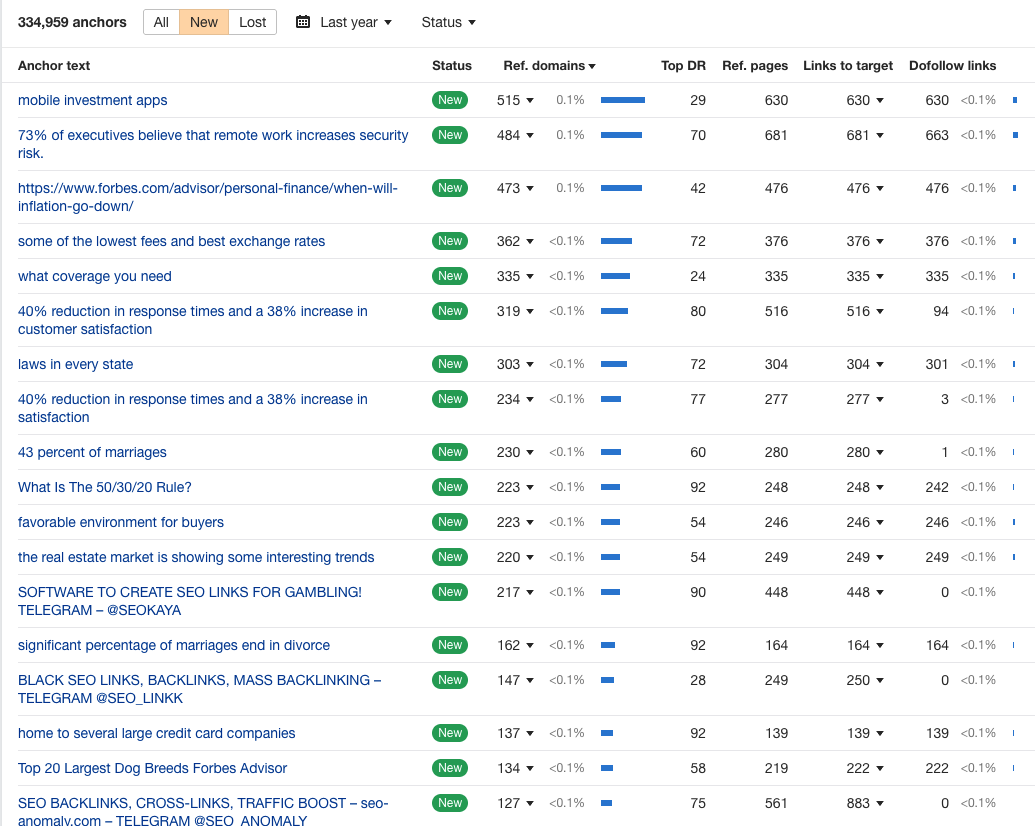
For example, that top anchor links to Forbes Advisor’s Top Remote Work Statistics.
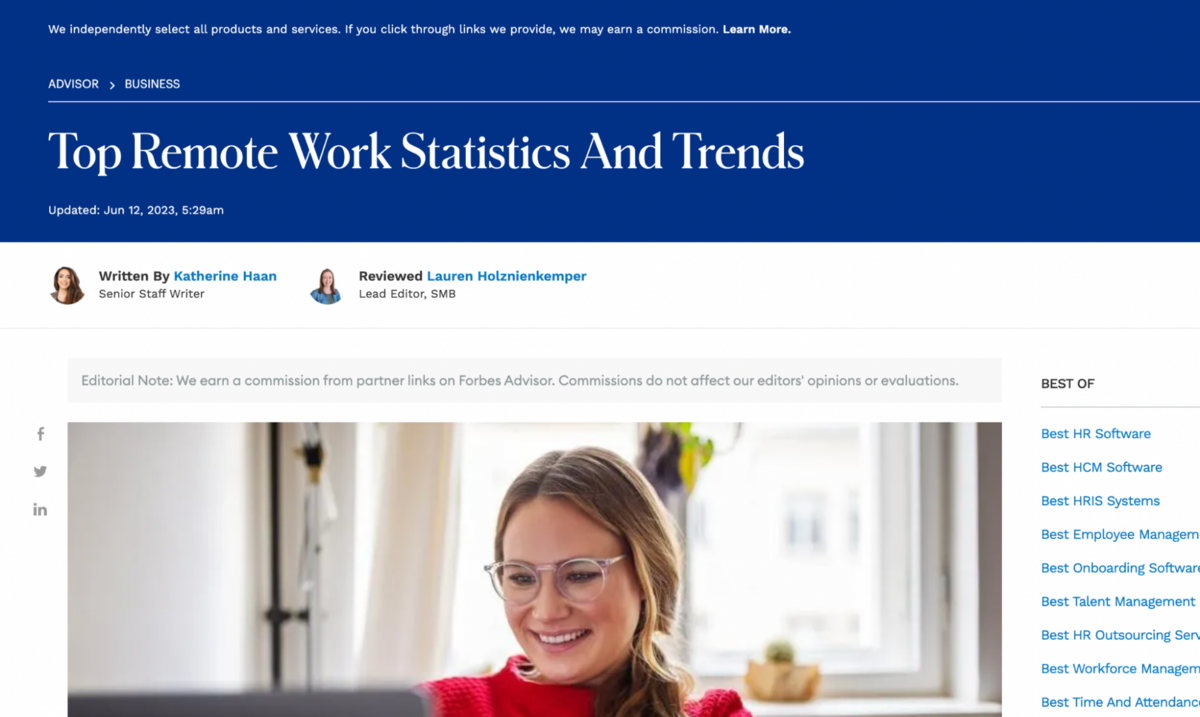
One of my favorite strategies is passive link acquisition.
In this strategy, you write a post around a keyword with high link intent.
The most common application of this is statistics or trends posts, where you compile a list of statistics (proprietary or pulled from around the web) around a keyword with high link intent.
Once this keyword ranks, it will drive links because researchers, bloggers, or journalists will search for it independently and cite it in their articles.
As it gains more links, it increases ranking and helps you gain more links, creating the flywheel.
Let’s look at the example for the aforementioned Top Remote Work Statistics.
Below, you can see they have a mix of externally sourced statistics as well as some of their own:
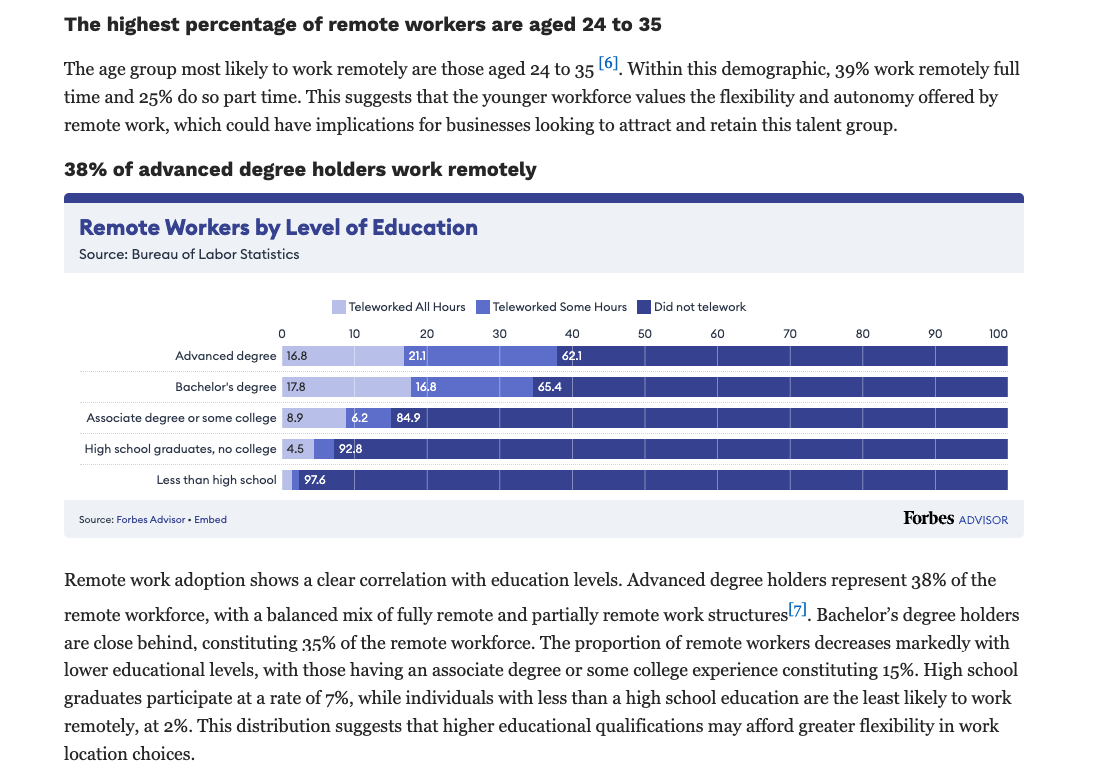
Sites like Microsoft, NYTimes, and Adobe link to this post:
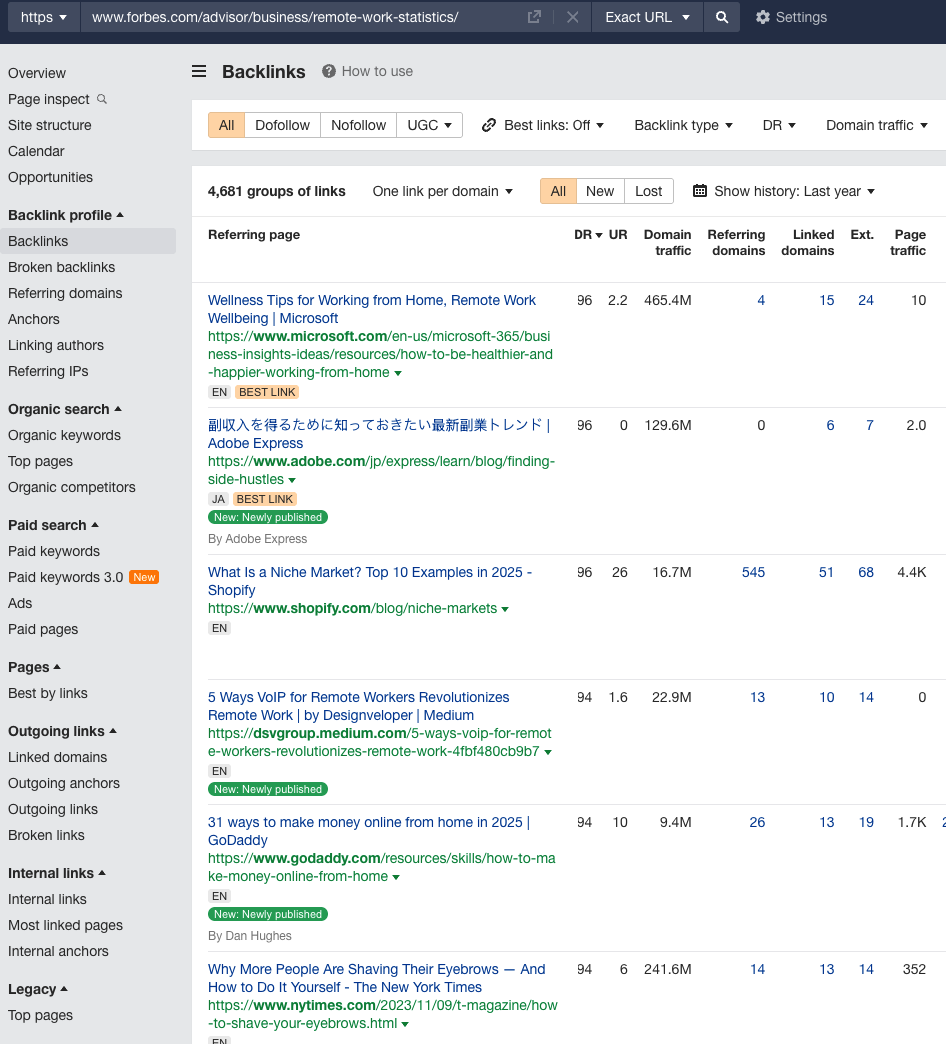
While this post’s search volume is small, it still has over 3K Referring Domains (RD).
They have 1,800 statistics posts bringing over 17.5k Referring Domains in the past year, according to Ahrefs.
The content itself doesn’t always have to be statistics; for instance, definitional content works well for this when you can get it ranking.
Forbes Advisor’s post on a definitional query like “smart goals” has garnered over 1,800 RD over time.
This passive link content can pass valuable link equity and authority when internally linked.
2. City Indexes
These are the classic city studies I’ve written about. In these, you rank cities (or states) based on a rubric of pre-determined categories.
Then, based on the “winners” (and sometimes losers), you pitch to the local news in those locations.
For example, their Cities with the Worst Drivers post has over 400 RD:
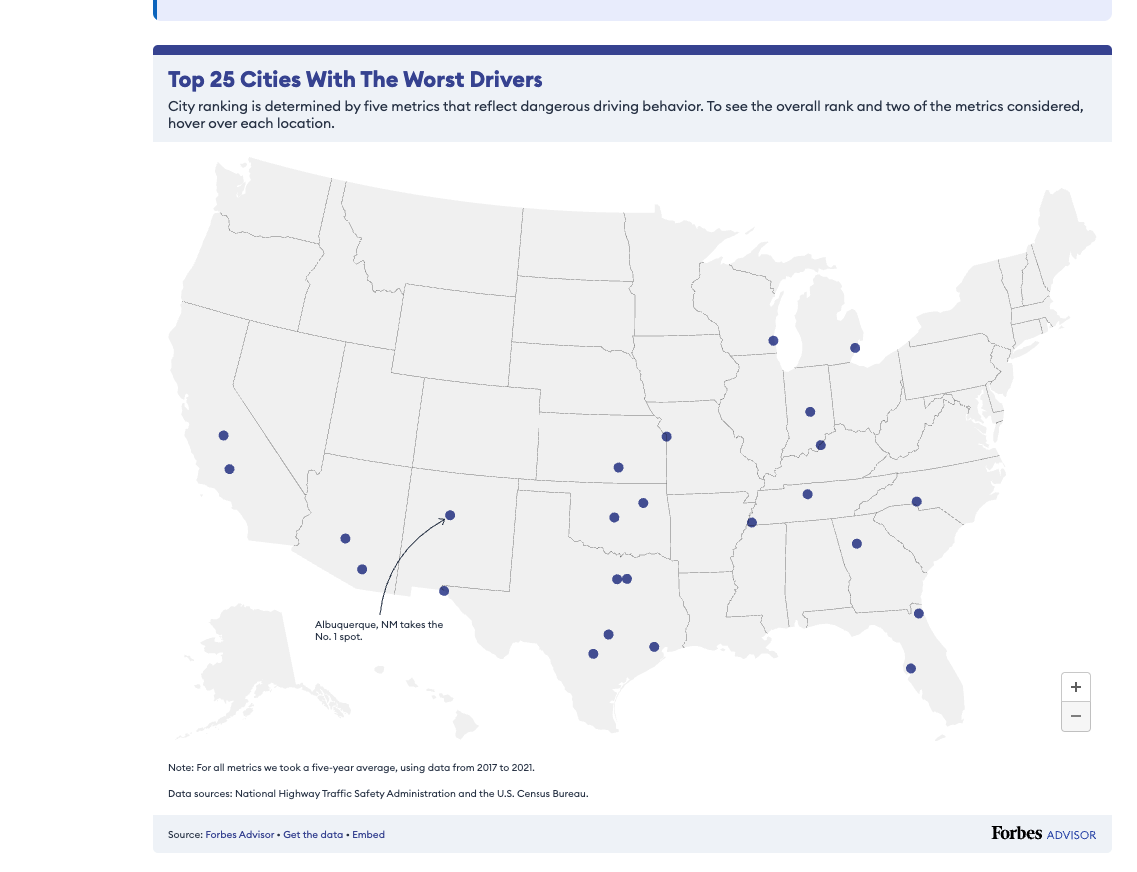
Or their Best Cities for Renters has 380 RD.
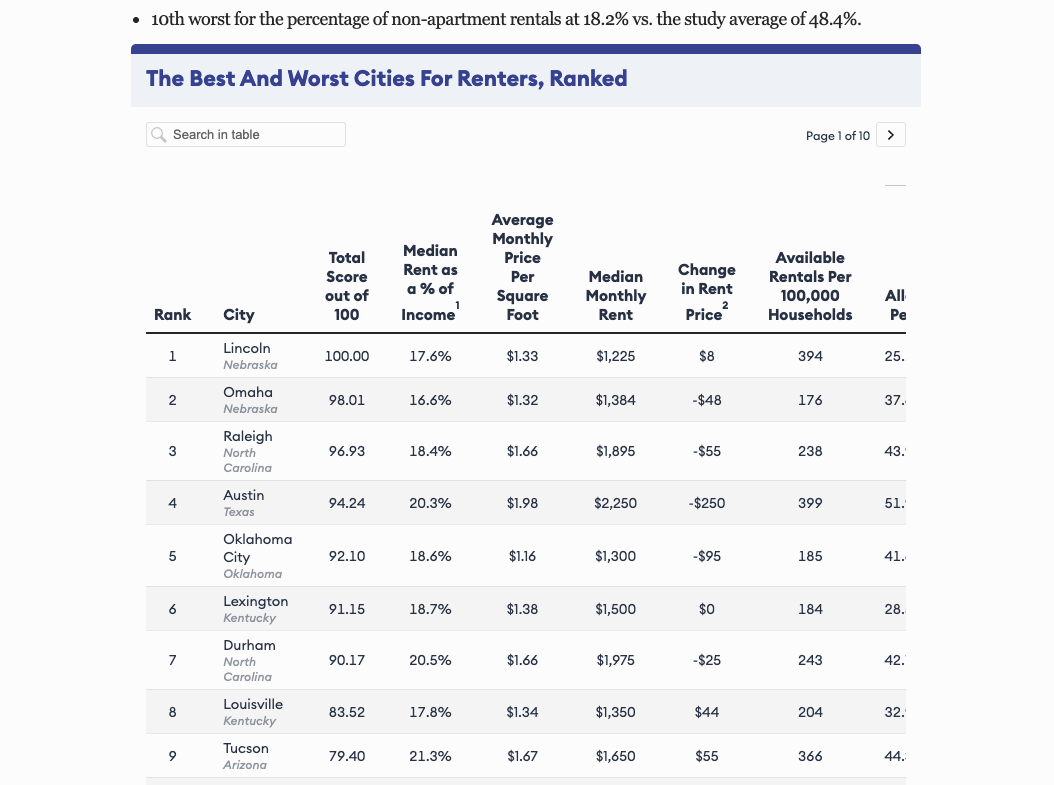
These posts can sometimes bring in organic traffic on their own, but more importantly, they can build brand authority in specific areas.
They have about ~40 city studies, accounting for 3.8K RD in the past year.
3. Survey Content
In most of their surveys, Forbes Advisor used Talker to gather responses and compile interesting stories to pitch to journalists.
For instance, here’s a post about digital wallet payment usage:
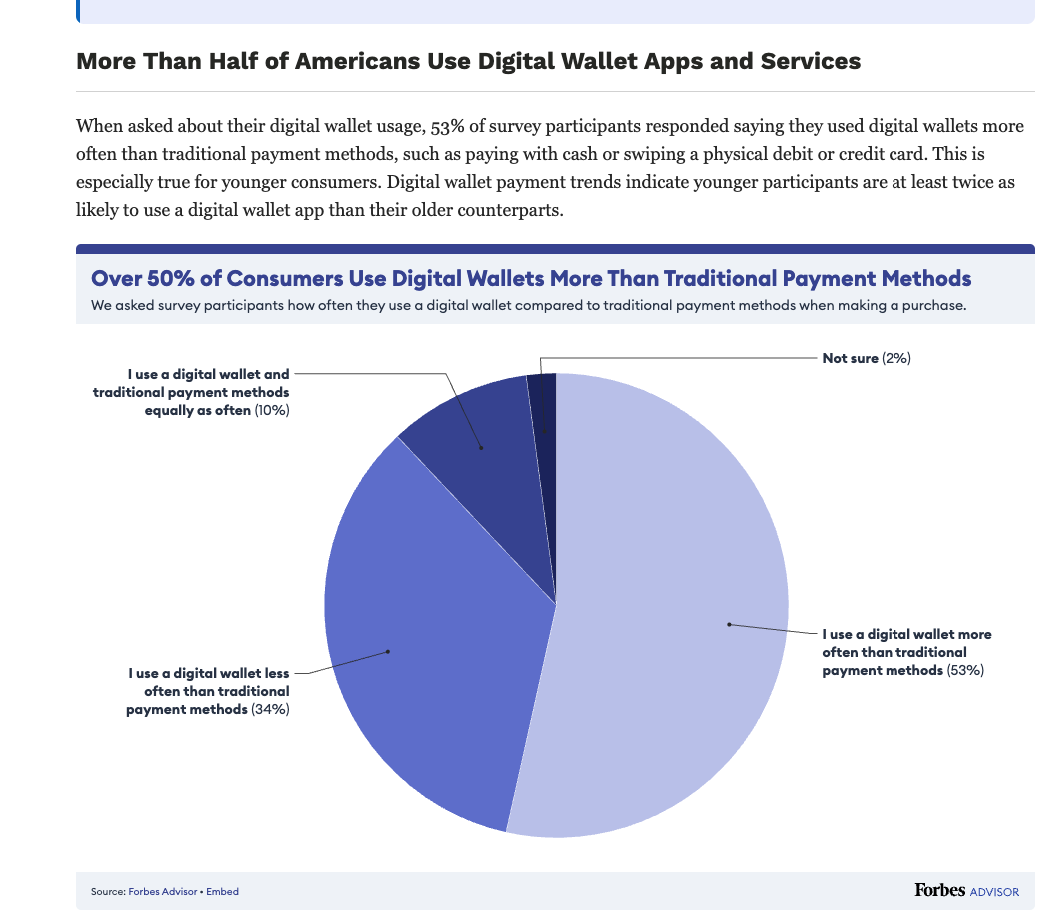
Here’s a backlink profile for their survey content about AI in Business:
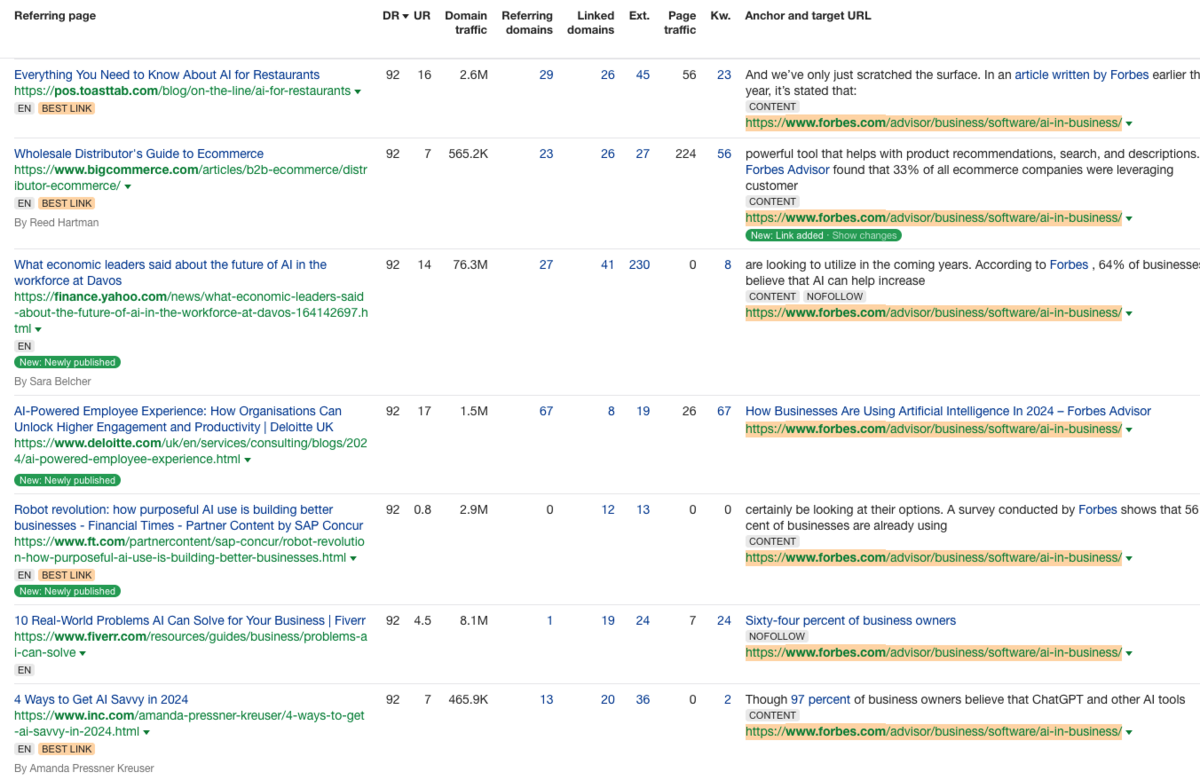
This post has over 3K RD, including citations in many top-tier sites, such as Inc, Financial Times, and Yahoo Finance.
Here is another, more study mapping search engine usage.
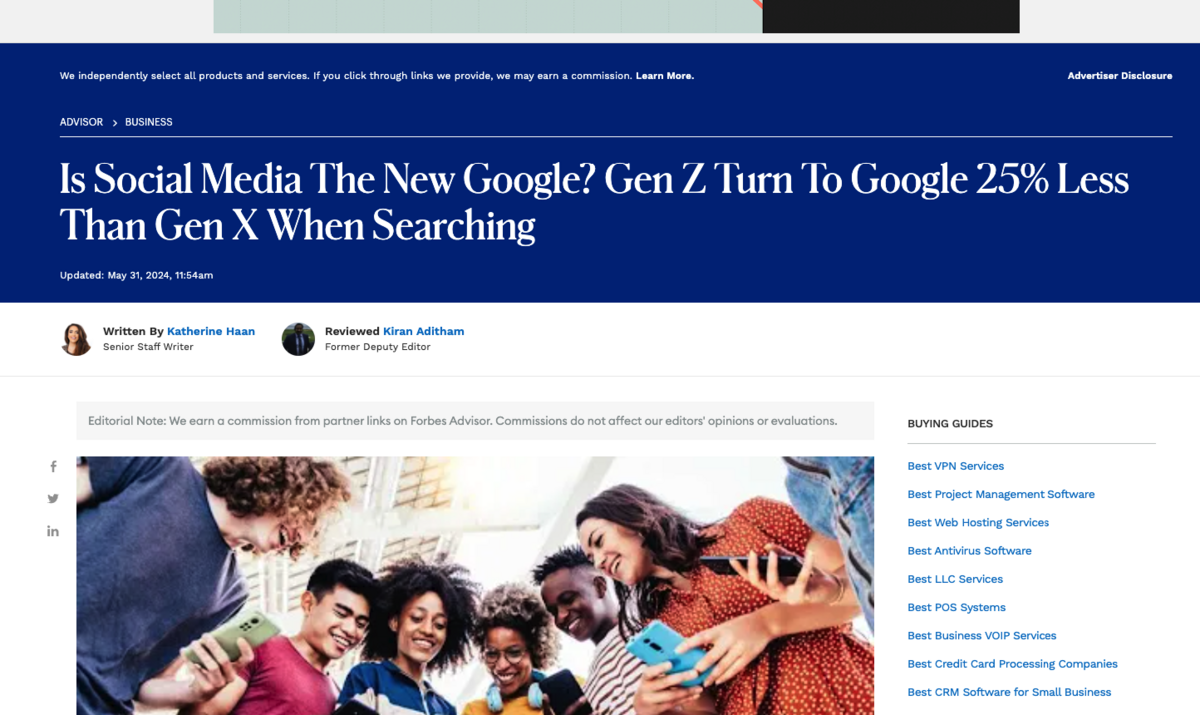
This got them 408 RD.
These quality survey studies have created newsworthy stories to yield thousands of top-tier links and coverage.
4. Citable Elements Within Content
This strategy takes a page from Garrett French/Citation Labs’ book.
Here is a roundup post about the Best Travel Insurance, ranking travel insurance online.
However, when you scroll down, you find some proprietary data included in the post:
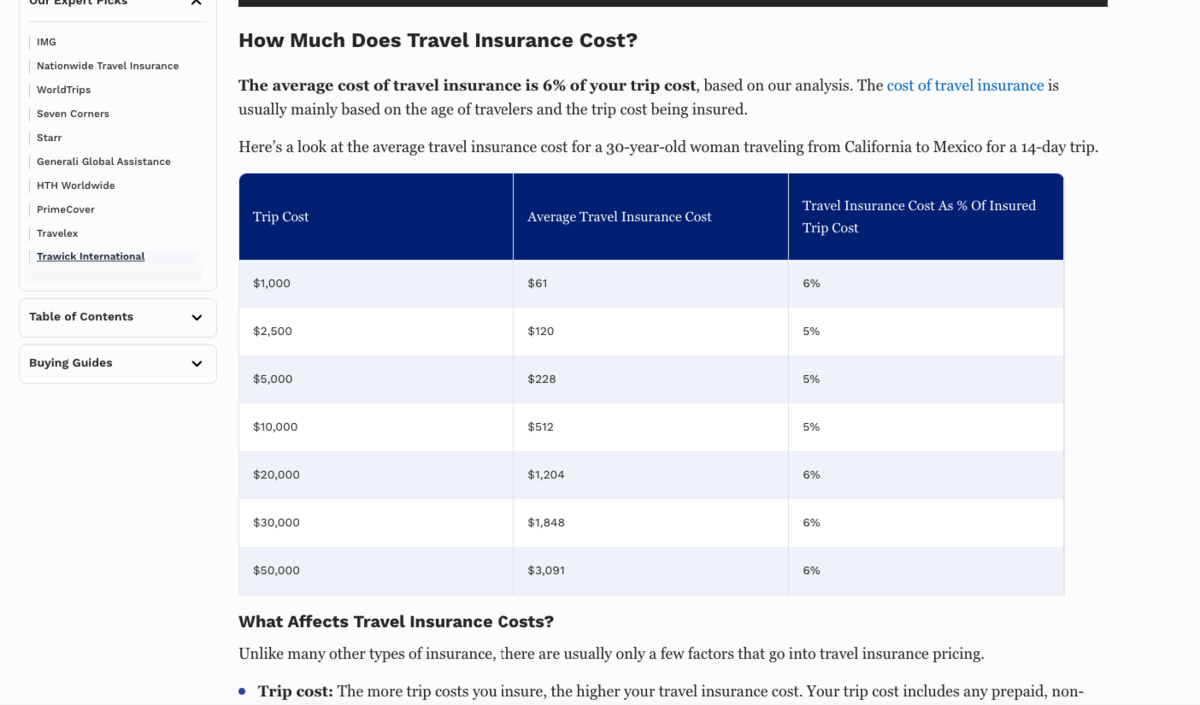
This makes the post pitchable for links.
They put a full data study within the ranking post and pitch this for links through a jump link:
https://www.forbes.com/advisor/travel-insurance/best-travel-insurance/#the_most_and_least_risky_cities_for_tourists_ranked_section
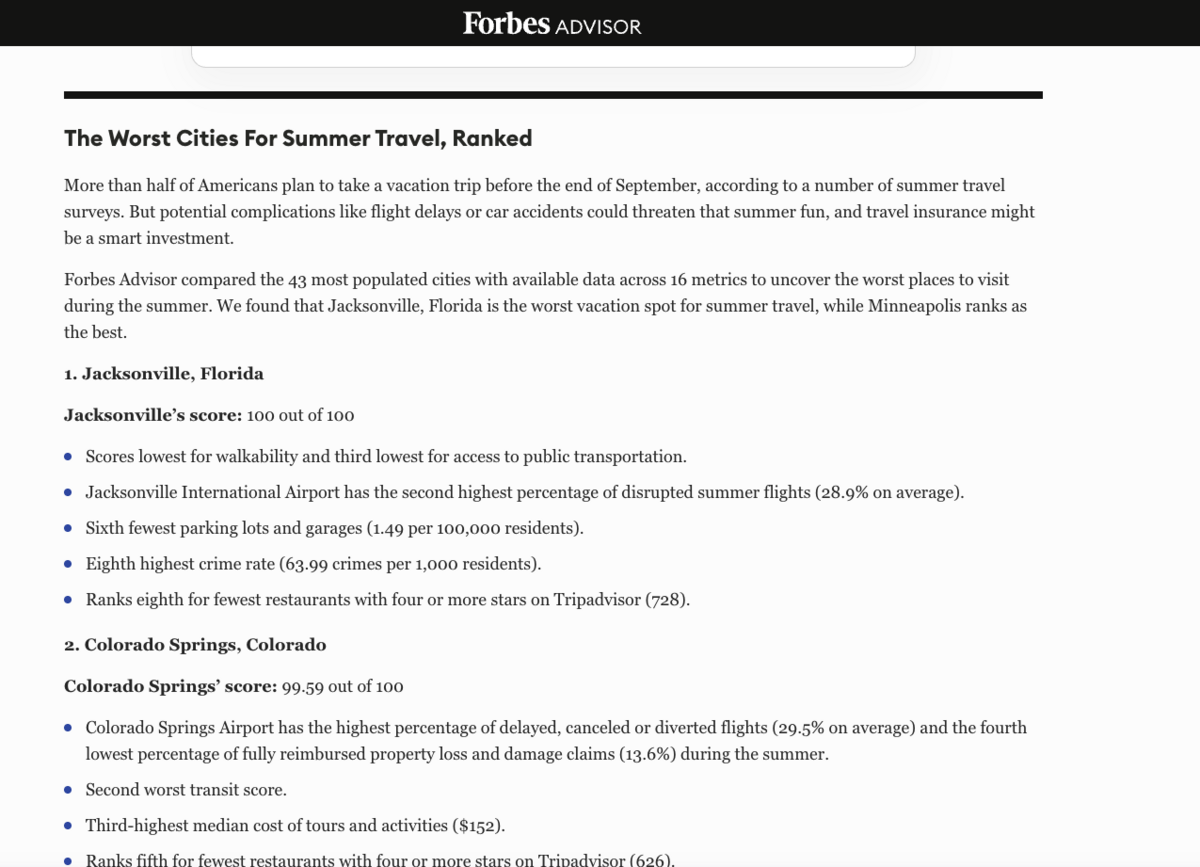
This gets links and mentions in news outlets like this:
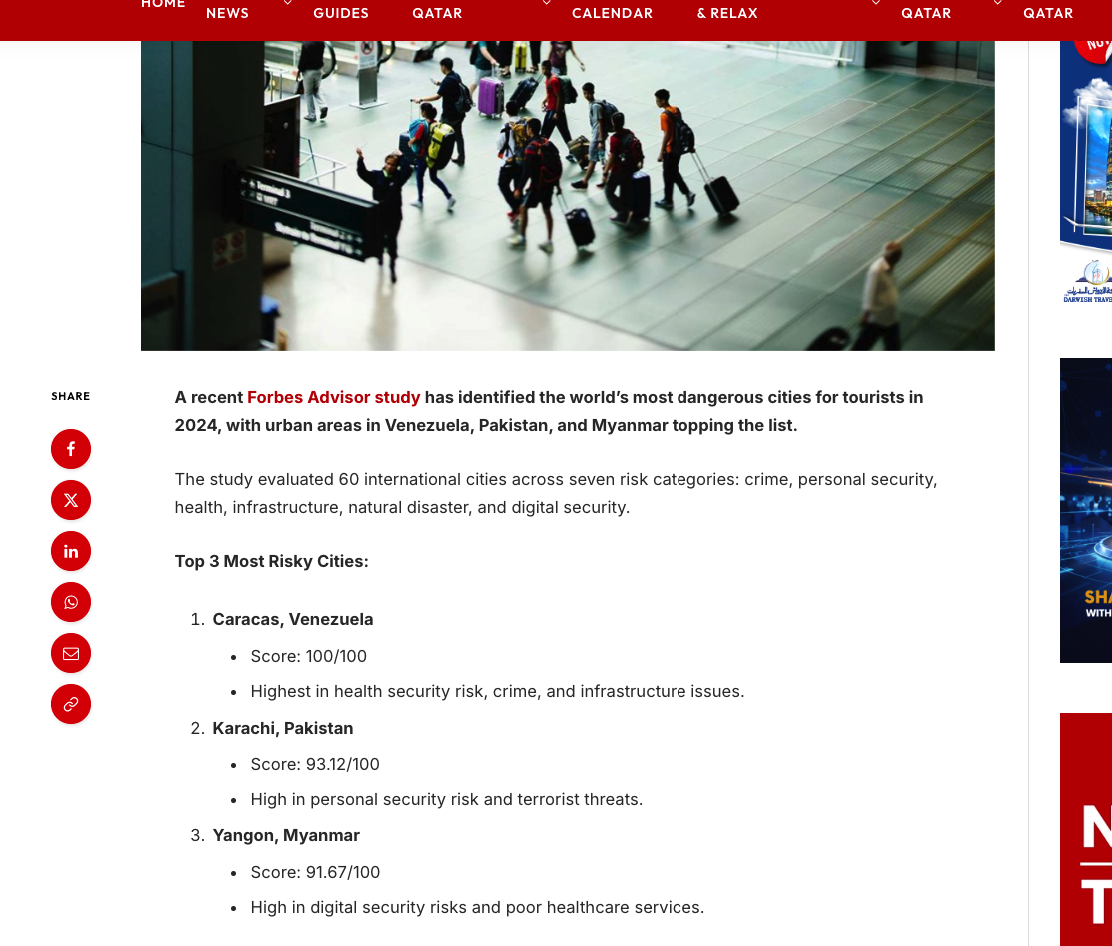
This is one way to get links for typically less linkworthy pages.
Overall, this was a powerhouse digital PR team (with a powerhouse budget) that helped power some serious brand authority.
Using Ahrefs’ new brand authority tool, we can see that the number of mentions skyrocketed in the years that the digital PR team was working.
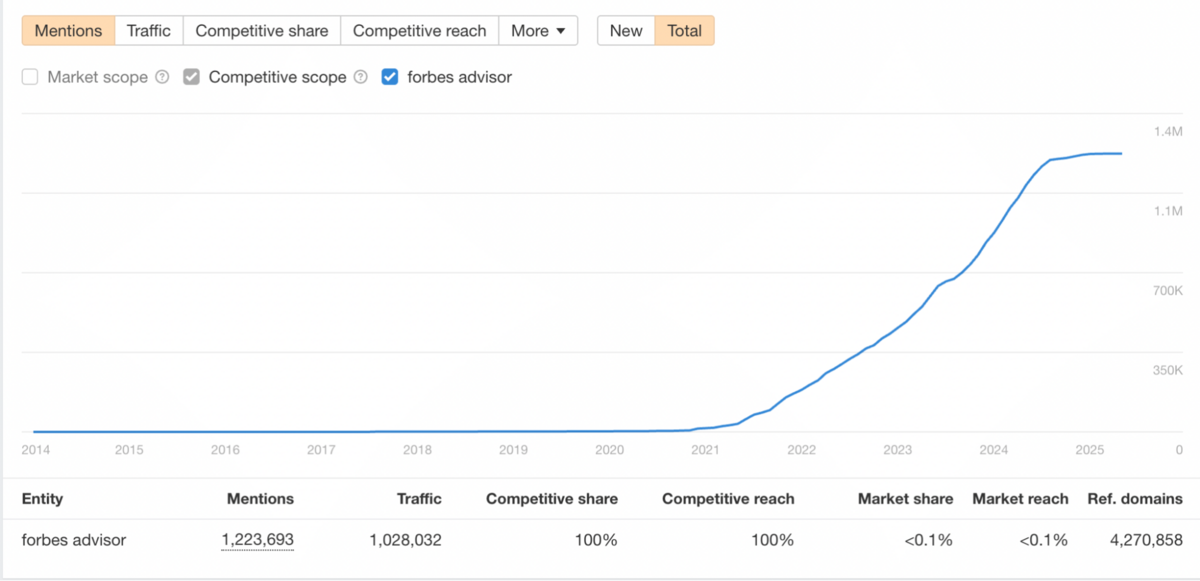
Then, every SEO’s nightmare: First HCU, and months later, manual action was taken for site reputation abuse.
Part Two: The Google Hits
Let’s focus on the macro look again to understand what categories were hit.
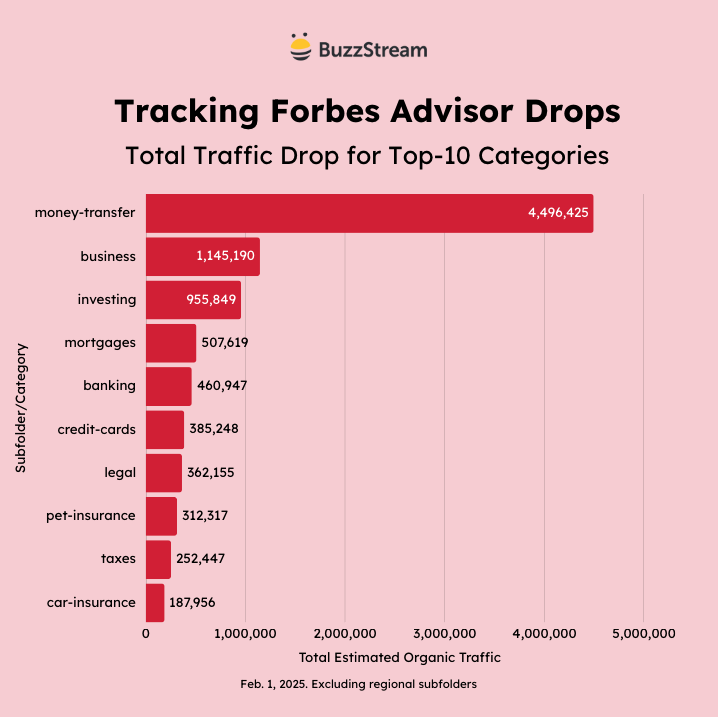
Money Transfer content was hit extremely hard (accounting for 44.6% of the traffic hit).
Their /business/ content also suffered. The informative content lost twice as much traffic (2.4M) as the software review content (1.1M).
For almost five grueling months, Forbes Advisor watched the traffic drain to zero, and multiple rounds of layoffs followed.
But then, early March, their traffic started to creep back up.
Part Three: The Comeback
Forbes is now starting to regain some traffic.

It’s only a fraction of what it once was, but it’s back.
According to Ahrefs, here is a look at the top-ranking posts as of May 5, 2025.
| URL | Traffic |
|---|---|
| https://www.forbes.com/advisor/money-transfer/currency-converter/aed-inr/ | 74,503 |
| https://www.forbes.com/advisor/mortgages/mortgage-interest-rates-forecast/ | 71,780 |
| https://www.forbes.com/advisor/mortgages/mortgage-rates-05-05-25/ | 61,283 |
| https://www.forbes.com/advisor/mortgages/real-estate/housing-market-predictions/ | 50,377 |
| https://www.forbes.com/advisor/credit-cards/travel-rewards/best-time-to-buy-flights/ | 47,477 |
| https://www.forbes.com/advisor/investing/cryptocurrency/top-10-cryptocurrencies/ | 44,882 |
| https://www.forbes.com/advisor/money-transfer/currency-converter/eur-usd/ | 41,020 |
| https://www.forbes.com/advisor/mortgages/best-mortgage-lenders/ | 39,568 |
| https://www.forbes.com/advisor/money-transfer/currency-converter/kwd-inr/ | 34,143 |
| https://www.forbes.com/advisor/money-transfer/currency-converter/aed-pkr/ | 33,748 |
As you can see, there’s still some /money-transfer/ content ranking. But I also see mortgage content creeping up in the top 10.
Let’s look at the complete breakdown of categories driving traffic:
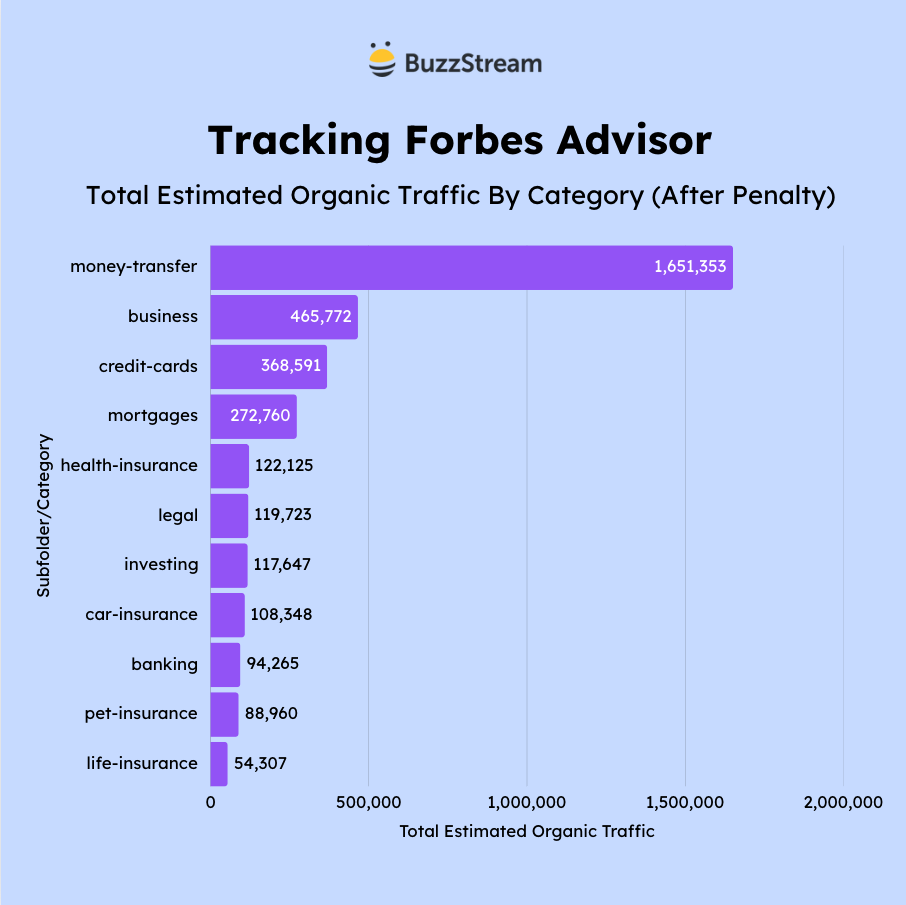
You’ll notice that the traffic isn’t nearly as significant as before.
We are talking about a maximum of 1.6M traffic for the /money-transfer/ section, which once had 6.6 million.
But to better understand what Google likes, let’s break it down into the sections again.
What Sections Are Gaining Traffic Now?
Here’s what the gains look like broken down by category.
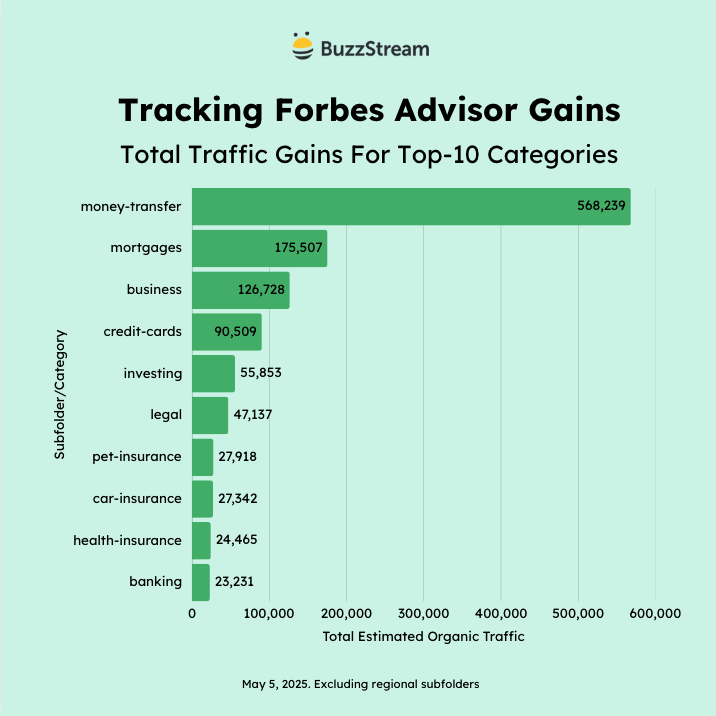
/Money-transfer/ took the most significant leap forward, followed by /business/ and /credit-cards/.
But why these sections?
What Did They Do Right?
Now that we know what recovered, we might better understand what may have influenced their recovery.
Cutting Ties With Freelance Writers
I must mention this first because this was a hot topic on the web. Forbes Advisor (among many other publishers) cut ties with freelance writers to combat Google’s penalties.
When I spoke with Mark (former Director of PR & Communications), he told me that he believed Forbes’ use of freelance writers for specific content was the main reason they got penalized for site reputation abuse, and removing freelancers was the main reason they returned.
But, to me, this is just a piece of the puzzle, because there is content ranking written by in-house writers that got hit, and vice versa.
So let’s look at a few more reasons.
Formed a Cohesive Brand
Although this may seem simple, bringing the Forbes Advisor content under the Forbes brand helps solidify the user experience.
Here it is before:
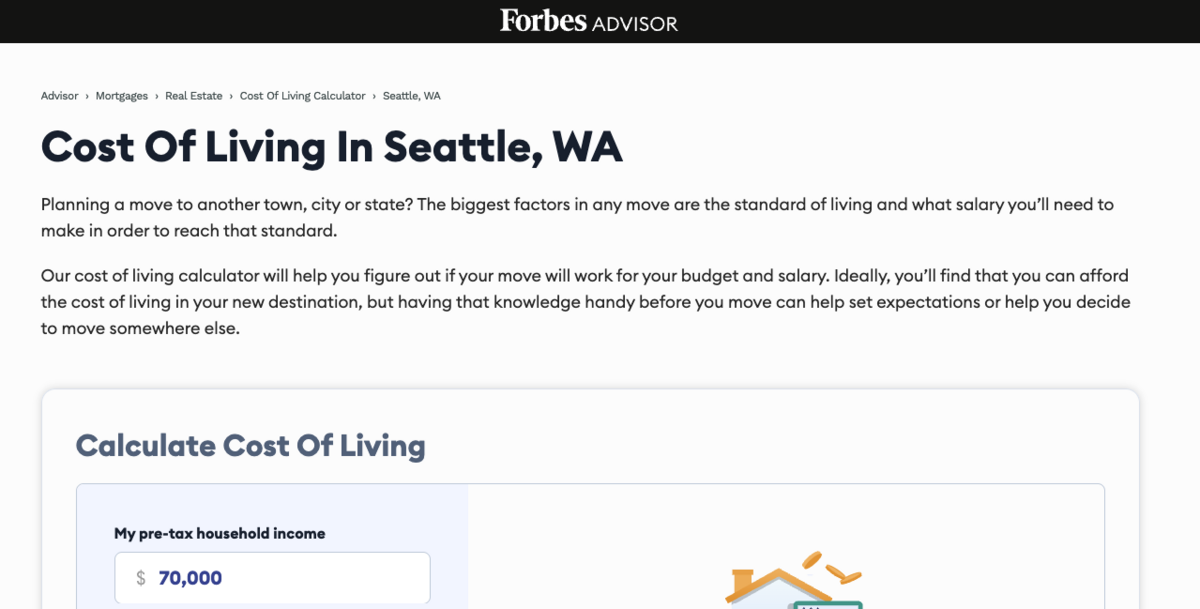
Here it is after:
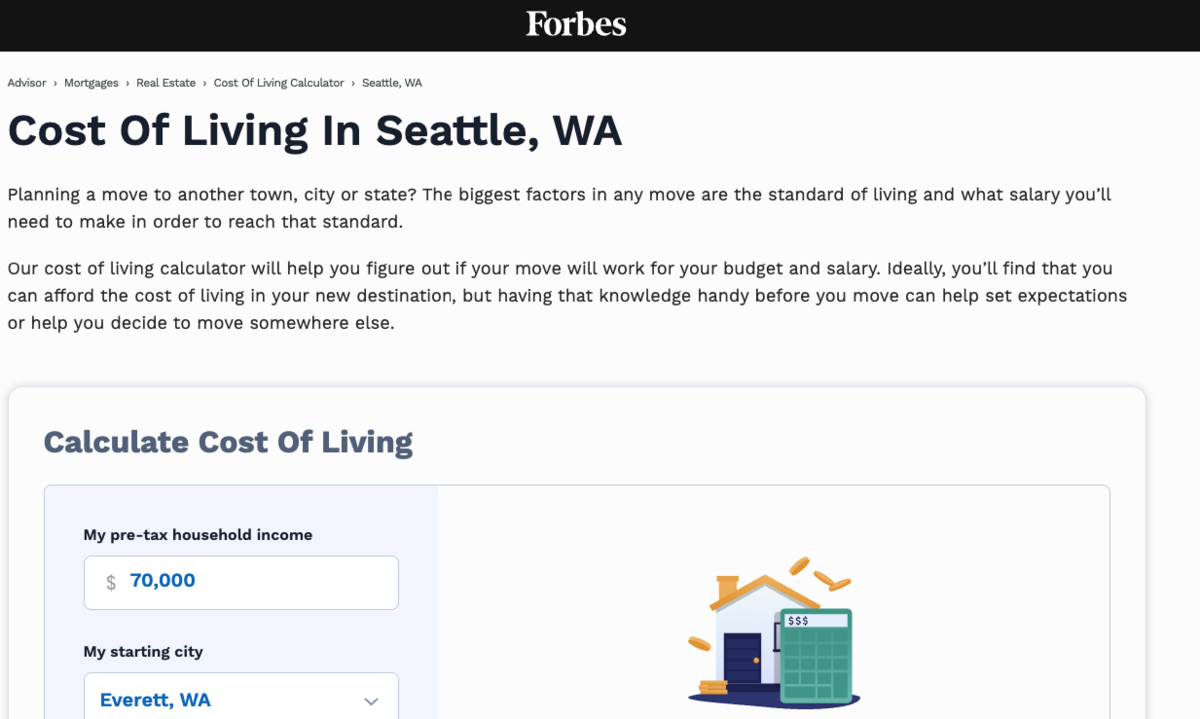
Although minor, I believe matching headers and branding is a subtle trust signal that users pick up on.
More Focus on Helpful Content
When comparing some of the content before and after, I see some changes that make it more Helpful.
Google outlined its guidelines for Helpful content in this great self-assessment document.
We also know they ask their search quality raters to focus more on this for industries and queries that are part of Your Money, Your Life (YMYL).
We can see less of a focus on affiliate clicks and more on helping the user solve the query.
Compare their /money-transfer/ pages before:

There was a much heavier focus on driving affiliate clicks than helping users solve the query.
Here it is now:
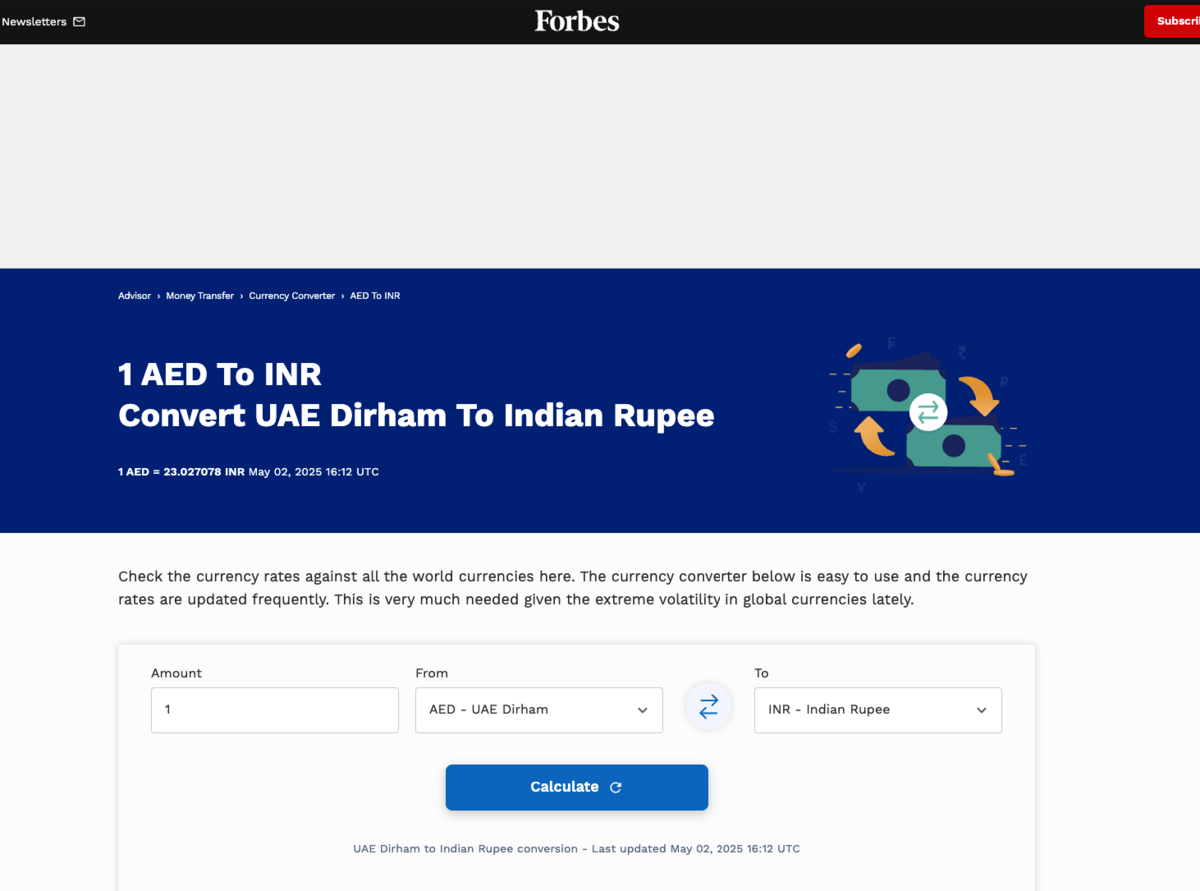
When I look at their “best” round-up and review posts, I also see changes that make things more Helpful for the user.
They’ve added Expert Take and Testing Insights to their drop-down modals:
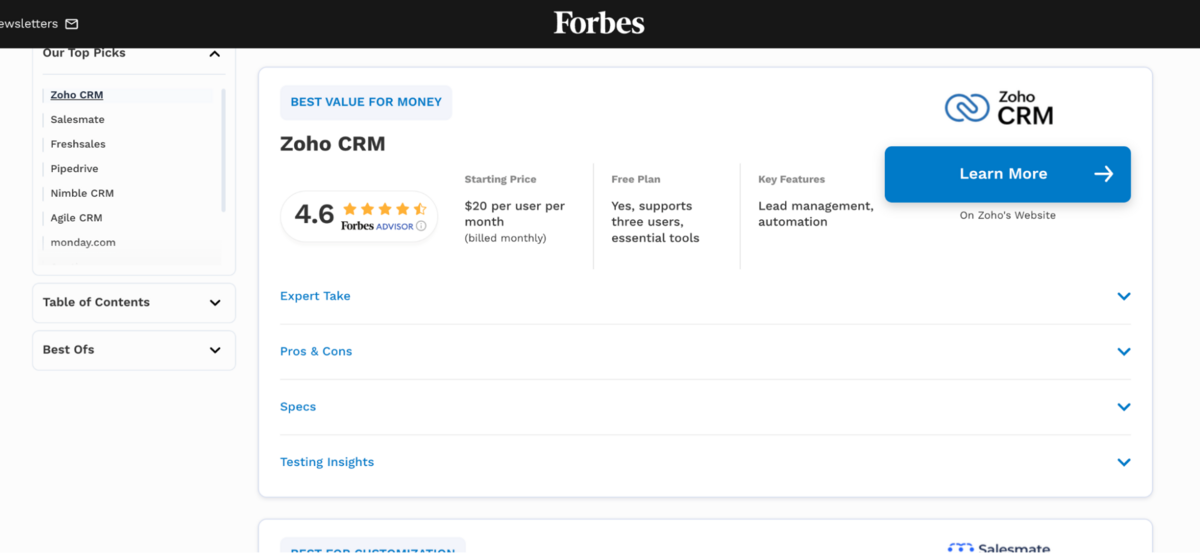
And when you expand them, you’ll find more information that feels a little bit more like they have actually used the software, complete with screenshots:
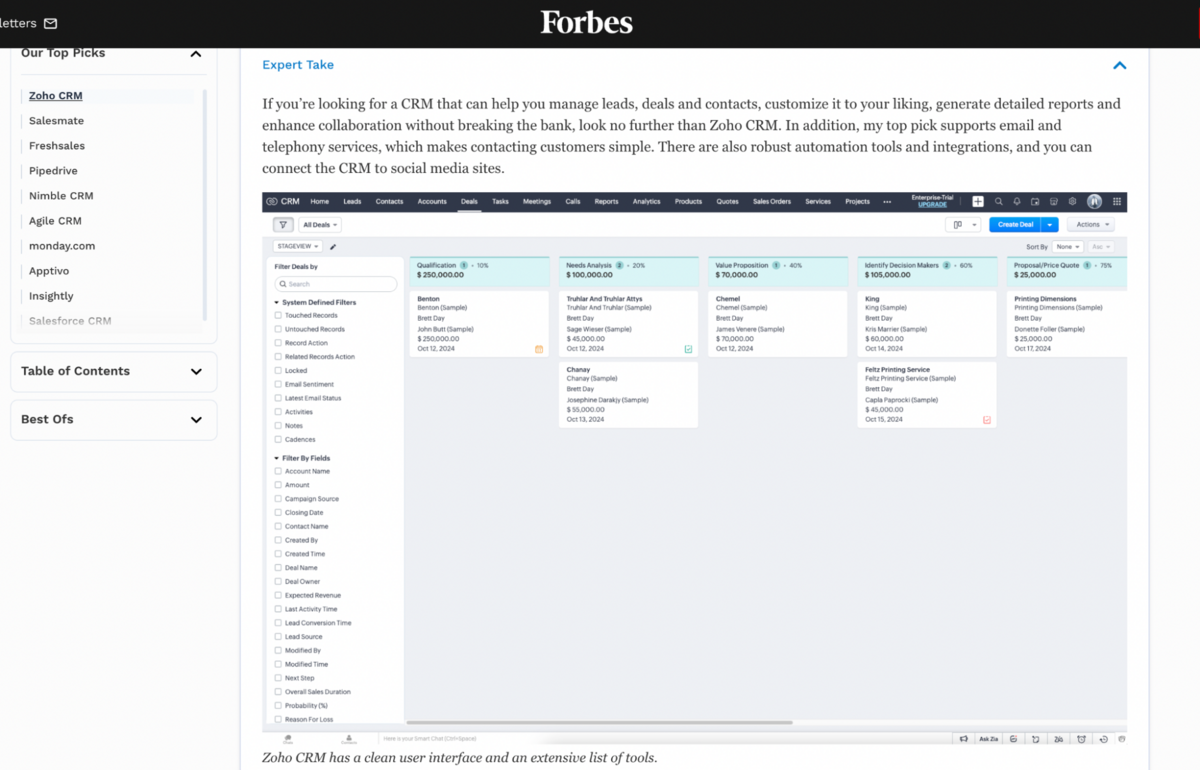
However, all of these things don’t happen in a vacuum. You still need brand authority. You need relevant links.
So, for the last section, I did some digging, and I believe their excellent digital PR work had a lot to do with their resurgence, but maybe not in the way you might think.
How Did Digital PR Help Forbes Advisor’s Resurgence?
To understand the digital PR team’s impact, I compared total traffic gains for the last three months to the RD for all content on /advisor/.
Here’s what I found:
Page-Level Correlation (individual posts)
At the page level, there’s a mild (weak) positive correlation of 0.14, meaning more links slightly align with higher traffic recovery if at all.
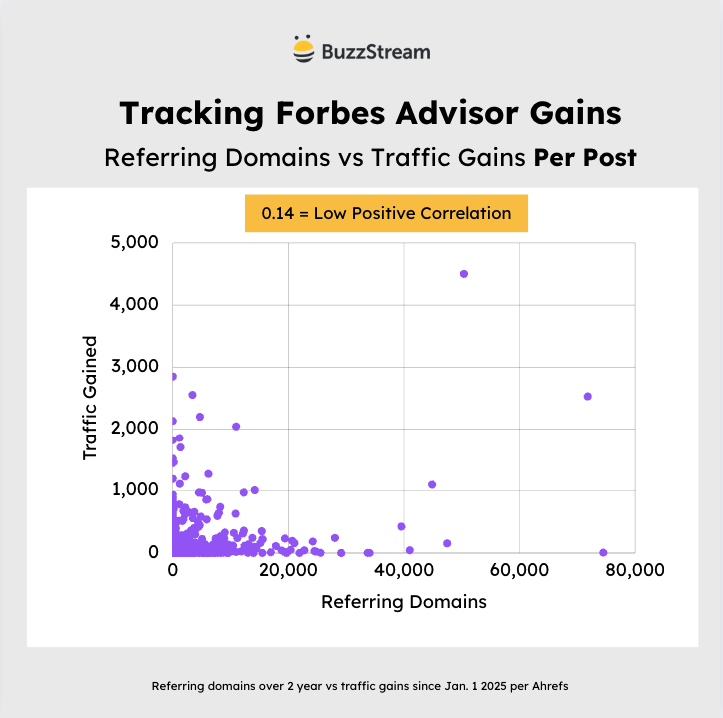
It’s not strong or predictive at the individual URL level.
That said, I wouldn’t expect them to recover as quickly or effectively if they didn’t have any links.
But the next section is what really stood out to me.
Category-Level Correlation (by folder)
At the category level, the correlation of RD to traffic gains is much stronger, at 0.77 on both the Spearman and Pearson correlation scales.
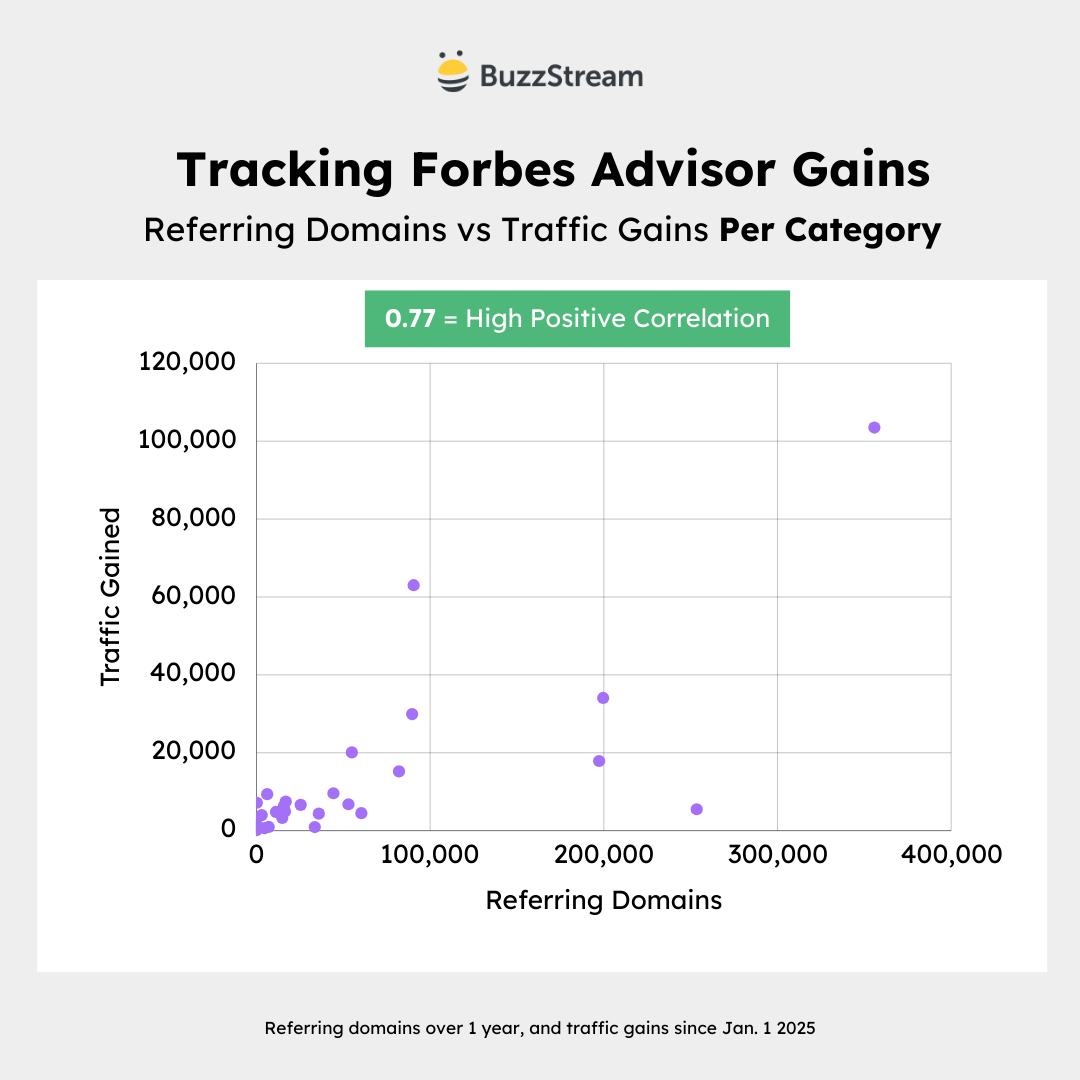
Remember that many factors are at play with this analysis, and correlation does not imply causation.
But Forbes Advisor’s recovery seems to benefit from its topical authority, built through close collaboration between the digital PR team and their Editorial counterparts to produce unique, newsworthy, and timely data-driven content, enabling the digital PR team to secure relevant, high-authority links.
Conclusion
My overall analysis may seem simple to some:
- Make your content more user-friendly and you’ll rank better.
- Get more relevant links to boost your authority, and you’ll be rewarded.
But often, I feel like we, as SEOs, get too caught up in manipulating text or title tags with keyword or AI optimization tools and lose sight of some of the apparent issues with our content.
Google has been targeting affiliate sites, but Forbes Advisor still somewhat survives after making changes. Google has also admitted to favoring larger sites, which may play a part in this.
Will this work for every brand?
The core principles of writing user-friendly content and getting relevant links are a solid foundation for any content marketing strategy for every site.

 End-to-end outreach workflow
End-to-end outreach workflow



 Check out the BuzzStream Podcast
Check out the BuzzStream Podcast







